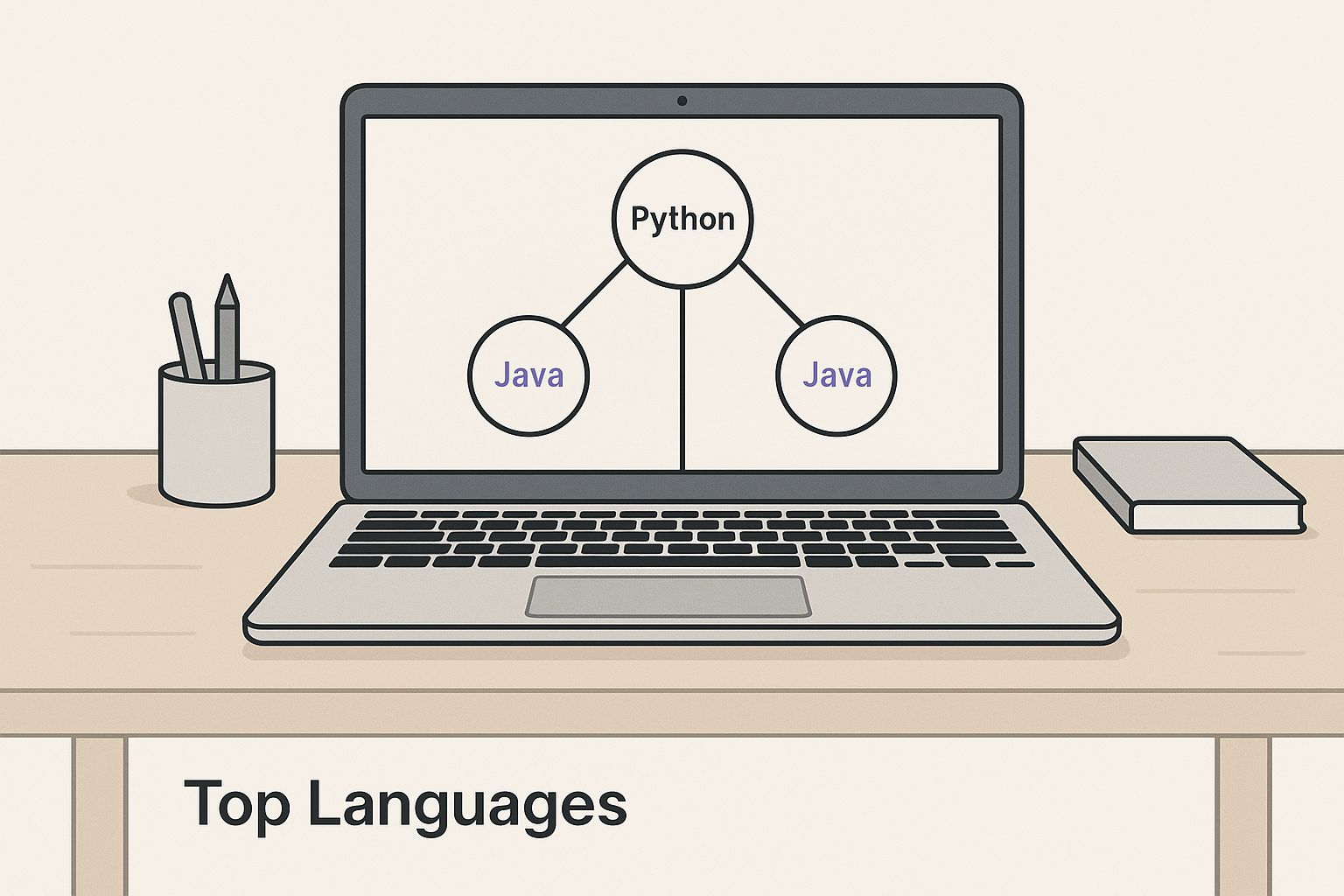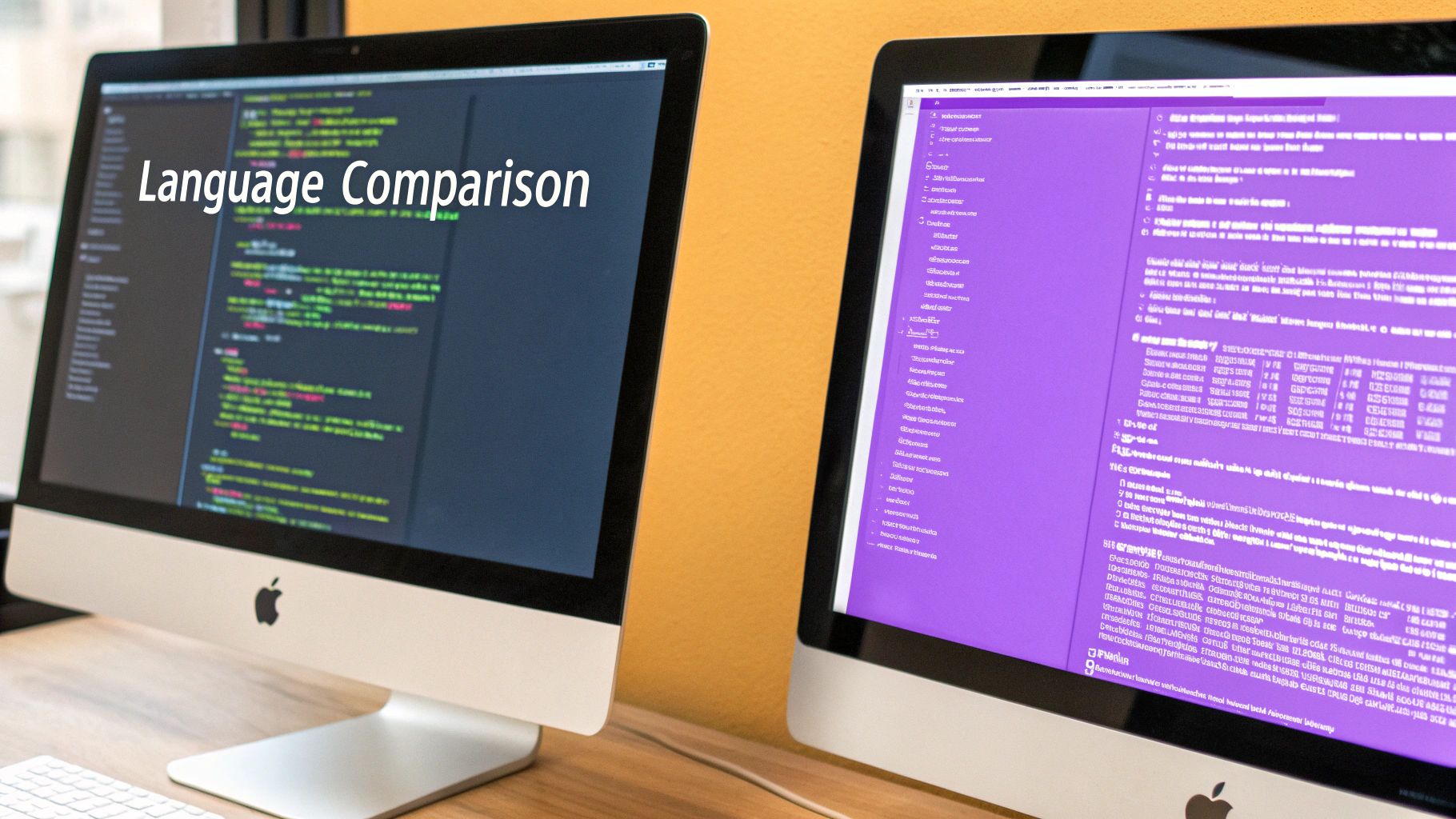Choosing Smart Contract Programming Languages

Smart contracts are the engine of the decentralized world. They're the self-executing bits of code that make everything from DeFi to digital art actually work. Picking the right smart contract programming language isn't just a technical choice—it's the first and most critical decision you'll make for your dApp.
Why Your Choice of Language Matters in Web3

Think of a smart contract as the "digital law" that runs a transaction on the blockchain, no trust required. Before you can write these laws, you have to pick the language. This one move ripples through your entire project, affecting its security, speed, and cost.
Your language choice ties you to a specific blockchain ecosystem. Some are native to Ethereum, the king of decentralized finance (DeFi), while others are built for speed demons like Solana. This decision dictates the tools you can use, the libraries you can import, and the developer communities you can tap into.
The Foundation of Security and Performance
A smart contract's whole purpose is to execute agreements securely and automatically. A single bug can lead to catastrophic losses—we’ve all seen the headlines. Different languages handle security in completely different ways.
- Security-First Design: Some languages, like Vyper, are built to be restrictive on purpose. They cut out complex features to shrink the attack surface and stop you from shooting yourself in the foot.
- Performance Optimization: Others, like Rust, are all about raw speed and memory safety. This makes them perfect for high-throughput apps like on-chain games or trading platforms where every millisecond counts.
This first decision sets the ceiling for your dApp's security and performance. It's way easier to build a secure app from the ground up with a security-focused language than to try and patch holes in a language known for its foot-guns.
Your choice of a smart contract programming language isn't just a technical preference; it's a strategic decision that defines your project's security posture and its potential for scale.
A Market on an Exponential Growth Trajectory
The stakes have never been higher. The global smart contract market, currently valued around $2.02 billion, is expected to explode to over $815 billion by 2034. That's a compound annual growth rate (CAGR) of over 82%—a clear signal that this tech is going mainstream.
This growth is creating a massive wave of opportunity. If you're looking to ride it, you can find a ton of remote Web3 jobs popping up.
Platforms are evolving to meet this demand, too. At Dreamspace, we’re building a vibe coding studio with an AI app generator to make development feel less like a chore and more like creating. It’s all about getting more creators into the Web3 game. If you want to dive deeper, check out our blog: https://blog.dreamspace.xyz.
For now, this guide will give you a clear map of the most popular languages so you can make the right call for your project.
Solidity: The Battle-Tested Ethereum Standard
If you’re stepping into the world of smart contracts, you’re going to meet Solidity first. It's the undisputed heavyweight champion in the Ethereum arena, born and bred for the Ethereum Virtual Machine (EVM). This makes it the native tongue for pretty much the entire world of decentralized finance (DeFi) and NFTs.
Created back in 2014, Solidity was designed with a clear purpose: to give developers a direct way to write code for the EVM. Its syntax feels a lot like JavaScript and Python, which was a brilliant move. It instantly lowered the barrier to entry for a massive pool of web developers, making the jump to Web3 feel a lot less intimidating.
This familiarity is Solidity's superpower. You’re never coding alone. You’re supported by a huge global community, powerful open-source libraries like OpenZeppelin for battle-tested contract templates, and a practically endless supply of tutorials.
Core Features and Syntax
At its heart, Solidity is a statically typed language. What does that mean? Simply that you have to declare what type of data every variable holds—whether it’s a number, a wallet address, or a string of text—right from the start. It’s a critical first line of defense, letting the compiler catch a whole class of potential bugs before your code ever touches the blockchain.
This focus on developer support is obvious from the moment you land on the official homepage, with docs, a blog, and community links front and center.
Another key concept is inheritance. This lets new contracts build on the properties and functions of existing ones. It’s a massive win for efficiency and security, allowing you to reuse audited, trusted code instead of reinventing the wheel every single time. A new token, for example, can just inherit from a standard contract to ensure it plays nicely with the rest of the ecosystem.
The Double-Edged Sword of Flexibility
Solidity gives you immense power, but it demands serious responsibility. The same high-level flexibility that makes it so great for building complex dApps has also been the root cause of some of Web3’s most notorious security nightmares. Things like reentrancy attacks and integer overflows have cost people millions.
Solidity grants developers incredible power to innovate on the blockchain. However, this power demands an unwavering commitment to security, as even minor coding oversights can have irreversible and costly consequences.
This painful history has baked a culture of extreme diligence into the community. Writing secure Solidity isn't just about knowing the syntax; it’s about adopting a security-first mindset and deeply understanding the potential pitfalls.
- Rigorous Audits: Independent security audits aren’t optional. For any serious project, they are a must-have.
- Security Tools: Pros lean on tools like Slither and Mythril to automatically scan code for known vulnerabilities.
- Best Practices: Sticking to established guidelines, like the Smart Contract Security Verification Standard (SCSVS), is non-negotiable.
As you sharpen your skills, knowing how to write Solidity code documentation becomes just as important for keeping your projects clean and collaborative.
This is where modern tools come in. Dreamspace, for instance, operates as a vibe coding studio and AI app generator designed to handle some of this heavy lifting, helping you generate solid smart contracts while sidestepping common mistakes. Despite its steep learning curve, Solidity's huge network, deep tooling, and massive developer base keep it firmly planted as the go-to standard for building on Ethereum and other EVM chains.
Rust And Vyper: The Security-Focused Challengers
While Solidity still rules the roost in the Ethereum world, its incredible flexibility has a dark side. It's the very thing that has led to some of the most infamous and costly hacks in crypto history. This has pushed the community to find better, safer ways to build, giving rise to new smart contract programming languages designed from day one with security baked into their DNA.
Two of the biggest names to emerge from this shift are Vyper and Rust.
If Solidity is a souped-up, endlessly customizable muscle car that can be dangerous in the wrong hands, then Vyper is like a high-security armored truck. Rust, on the other hand, is a precision-engineered F1 engine built for pure, unadulterated performance and reliability.
Vyper: The Security-First Language
Vyper was built on a simple, powerful idea: make it nearly impossible for developers to write bad code. It takes a deliberately minimalist approach, ditching complex Solidity features like inheritance and modifiers. Why? Because those are precisely where bugs and exploits love to hide.
By stripping away the complexity, Vyper forces you into a more direct, auditable coding style. Its syntax is heavily inspired by Python, which makes it a breeze to read for a huge number of developers. This isn't just about looks; it's a security feature. Code that’s easy to read is also far easier to audit for flaws.
Vyper's goal isn't to give you a million features. It's to provide a secure, understandable foundation. It's all about audibility and simplicity, making it a fantastic choice for financial apps where there's zero room for error.
This focus on security has a nice side effect: it's also more efficient. Vyper’s simpler design creates cleaner bytecode, which often means lower gas fees for your users.
Rust: The Performance Powerhouse
Where Vyper zigs toward simplicity, Rust zags toward raw performance. It was born to build incredibly fast and concurrent applications without compromising on safety. Originally a Mozilla project, Rust has become the go-to language for next-gen blockchains like Solana, Polkadot, and Near—all platforms where high transaction speeds are the name of the game.

Rust’s secret weapon is its "ownership model." This is a strict set of rules the compiler enforces to guarantee memory safety before your code ever runs. It wipes out entire classes of bugs like null pointers and buffer overflows that have been a nightmare for developers for decades.
This obsession with performance and safety has made Rust a fan favorite well beyond just crypto. For smart contracts, it means you can build seriously complex applications with confidence, knowing the compiler has your back. The trade-off? The learning curve is definitely steeper than Solidity or Vyper. But for projects that need that top-tier performance, it’s a price well worth paying.
Comparing Solidity Rust And Vyper
Choosing a language often comes down to the specific needs of your project. This table breaks down the core differences between the big three to help you decide which tool is right for the job.
Ultimately, there's no single "best" language. Solidity's dominance on Ethereum gives it a huge advantage in community support, while Vyper offers a safer path for financial applications on the same chain. For anything needing sheer speed, Rust is in a class of its own.
A Diversifying Landscape
The rise of Rust and Vyper is a sign of a healthy, maturing ecosystem. As blockchains evolve beyond Ethereum, developers need more specialized tools to tackle new challenges. While Solidity remains king, languages like Michelson (for Tezos) and DAML are also carving out their own niches.
This diversity is great for Web3. It means you can pick the right tool for the job.
- Building a DeFi protocol on Ethereum? Vyper gives you a safer, more auditable alternative to Solidity.
- Creating a high-speed game on Solana? Rust is pretty much a non-negotiable.
- Want to innovate without the steep learning curve? New tools are abstracting the complexity away. Platforms like Dreamspace, which acts as a vibe coding studio and AI app generator, let creators generate secure contracts in their language of choice using a more intuitive approach.
In the end, having more options empowers developers. It lets us move beyond a one-size-fits-all world and choose the language that truly fits a project’s unique needs for security and performance.
How To Choose The Right Smart Contract Language

Picking from the ever-growing menu of smart contract programming languages isn't just a technical detail—it's a move that defines your project's entire trajectory. The right choice can fast-track development, bulletproof your security, and plug you into a massive, supportive ecosystem. Get it wrong, and you could be staring down the barrel of costly hacks, sluggish performance, and a world of developer frustration.
Let's be clear: there is no single "best" language. It's a myth. The real goal is to find the best fit for your specific project, your team's existing talent, and the blockchain you’re calling home. To get there, you need to start with the right questions.
Define Your Project's Core Needs
Before a single line of code gets written, you need to get brutally honest about your project's non-negotiables. Are you building a DeFi protocol that will one day guard millions in assets? Or is it a Web3 game that needs to crank out thousands of transactions every second? These two projects live in completely different worlds.
A DeFi team creating a sophisticated lending protocol on Ethereum will naturally gravitate toward Solidity or Vyper. For them, security and auditability are everything, and they'll happily accept the trade-offs of the Ethereum ecosystem to tap into its deep liquidity and massive user base.
On the flip side, a team building a high-frequency trading bot or a fast-paced game on Solana would see Rust as the only real contender. Here, performance is king. They need the raw speed and memory safety that Rust delivers to make their app feel responsive and, frankly, usable.
The core function of your application dictates its technical requirements. A project demanding airtight security has different language needs than one that requires blazing-fast performance.
Assess Your Team's Expertise
The perfect language is one your team can actually wield with confidence and security. A language's learning curve and your team's current skills are massive factors that directly hit your timeline and budget.
- JavaScript/C++ Background: If your team speaks JS or C++, they'll find Solidity’s syntax feels familiar. This comfort can seriously slash your initial development time.
- Python Proficiency: Got a crew of Python pros? Vyper is an obvious and excellent choice. Its clean, Python-like syntax is a dream to read and write, which almost always leads to safer, more auditable code.
- Systems Programming Experience: Developers who are comfortable with C++ or other low-level languages are the best candidates to take on Rust's steeper learning curve. The initial grind pays off big time in sheer performance and safety.
For teams trying to skip the steep learning curve entirely, a new wave of tools is changing the game. This is where a vibe coding studio like Dreamspace enters the picture, offering an AI app generator to simplify contract creation. And for anyone looking at even faster development cycles, it's smart to check out the best low-code development platforms and see how they can fit into a Web3 strategy.
Consider The Blockchain Ecosystem
Finally, your choice of language is often handcuffed to your choice of blockchain. While some languages are more flexible, many were purpose-built for specific chains, and you ignore that at your own peril.
- Ethereum & EVM Chains: Solidity is the undisputed king here, giving you keys to the kingdom: the largest ecosystem of tools, libraries (like the essential OpenZeppelin), and developers. Vyper is also a first-class citizen in this world.
- Solana, Polkadot, Near: These high-performance chains were built on a foundation of Rust. If you want to tap into their full potential for speed and parallel processing, Rust is a must.
- Stacks (Bitcoin Layer): This unique ecosystem uses a language called Clarity, which was designed from the ground up for predictability and security by tying directly into the Bitcoin network.
By methodically weighing your project's needs, your team's skills, and your target ecosystem, you're not just guessing—you're building a practical framework for your decision. This way, the language you choose becomes less of a technical chore and more of a strategic asset powering your vision.
The Future of Smart Contract Creation
We've seen smart contract programming languages grow up. The journey from Solidity to security-focused alternatives like Vyper and Rust has been a huge leap forward. But the next revolution isn't about learning another language. It's about completely changing how we build.
The real game-changer is artificial intelligence. Forget the days of manually hunting for every tiny vulnerability or spending countless hours trying to squeeze out a little more gas efficiency. AI is stepping in as your co-pilot.
Imagine writing a function and having an AI instantly red-flag a potential reentrancy attack. Or suggest a different data structure that could save your users on gas fees. This isn't a distant dream; it's happening now. AI tools are becoming the tireless security partner every developer wishes they had.
The Rise of AI-Powered Development
This shift is tearing down the old barriers. You no longer need a decade of niche experience to build something meaningful on-chain. The whole point is to abstract away the most tedious, repetitive, and frankly, nerve-wracking parts of the job.
The next wave of Web3 innovation won't just come from seasoned blockchain engineers. It will be unlocked by tools that empower artists, entrepreneurs, and community leaders to build secure on-chain applications with confidence.
This AI-driven approach zeroes in on the biggest headaches for developers:
- Automated Security Audits: Think of an AI trained on thousands of contracts—both the good and the catastrophically bad. It can spot dangerous patterns in your code that even a tired human eye might miss.
- Gas Fee Optimization: AI can simulate transaction costs and propose smarter code structures, helping you build apps that don't burn a hole in your users' wallets.
- Boilerplate Code Generation: Need a standard ERC-721 contract for your new NFT drop? AI can spit out a battle-tested template in seconds, letting you focus on the creative logic that makes your project unique.
A New Creative Paradigm with Dreamspace
This is where platforms built for the future are making a name for themselves. Dreamspace is a perfect example. It’s a vibe coding studio designed to make building on the blockchain feel less like a chore and more like a creative jam session. As an AI app generator, Dreamspace is right on the front lines of this movement.
It helps you design, build, and ship your vision with way less friction. Instead of wrestling with raw syntax and security nightmares from the get-go, you can generate solid smart contracts, pull on-chain data, and launch faster and with more confidence. If you're curious how these tools are changing the game, you can dive deeper into the best AI app generators and see what they're capable of.
By taking over the heavy lifting, platforms like Dreamspace are throwing the doors to Web3 wide open. They're making development faster and safer for a new generation of creators who have the ideas but not necessarily the hardcore engineering background. The future of building smart contracts is one where your vision, not just your coding skill, is what truly matters.
Smart Contract FAQs
Diving into smart contract programming can feel like learning a new dialect. Lots of questions pop up, especially when you're trying to figure out where to start or how to piece together a complex project. Let's clear the air on some of the most common ones.
What's the Easiest Language for a Beginner?
This really depends on where you're coming from. There's no single "easiest" language, but there's definitely one that will feel more intuitive based on your background.
If you've spent time in the web dev world, particularly with JavaScript, Solidity is your most natural starting point. The syntax will feel familiar, and the massive amount of tutorials, docs, and community support means you'll never be stuck for long.
On the other hand, if Python is your jam, you’ll feel right at home with Vyper. It was built with a Python-like syntax to be clean, simple, and readable. That design choice makes it arguably easier to write secure code from day one, because it intentionally cuts out a lot of complexity where bugs love to hide.
Can I Mix and Match Languages in One DApp?
Great question. It helps to think about the difference between a single contract and a full-blown decentralized app (DApp). A single smart contract has to be written in one language—it needs to compile down to bytecode for a specific blockchain's virtual machine.
But a complete DApp? That's a different story. It's an ecosystem, often made up of many different smart contracts working together. In that world, you absolutely can use different languages.
Think of a DApp as a multi-lingual system. You could have your core logic on Ethereum, written in Solidity for its battle-tested security, while a high-speed gaming component lives on Solana, written in Rust for performance. A cross-chain bridge lets them talk.
This approach lets you pick the right tool for the right job, optimizing each part of your application for what matters most—security here, speed there.
How Big of a Deal Is Gas Optimization?
It’s extremely critical. Seriously. On chains like Ethereum, high traffic can make transaction fees (gas) skyrocket. Inefficient code isn't just a technical flaw; it's a user experience nightmare. If every click in your DApp costs a small fortune, your users will bail for a cheaper alternative. Fast.
Your choice of language matters—Vyper, for instance, is built to be more gas-efficient. But honestly, your own coding habits are the biggest factor.
Gas optimization isn't something you bolt on at the end. It has to be part of your thinking from line one. This means:
- Smart Data Types: Use the smallest integer that works (like
uint128instead ofuint256if your numbers will never get that big). - Minimal On-Chain Storage: Storing data on-chain is expensive. Get clever with how you manage state, and use events to log data off-chain.
- Lean Logic: Write your functions to do the job with the fewest computations possible.
If you're trying to get a handle on all the lingo, a good Web3 Dictionary can be a lifesaver.
Are Smart Contracts Actually Secure?
A smart contract is only as secure as the code it’s written in. The blockchain's immutability is a double-edged sword: once deployed, the code is locked in forever. If it's perfect, it's incredibly secure. If it has a bug, that vulnerability is set in stone.
Security isn't a feature; it's the whole point. Getting it right involves:
- Choosing a secure-by-design language: Languages like Vyper and Rust were built from the ground up with security in mind.
- Following best practices: Know thy enemy. Stick to established security patterns to dodge common traps like reentrancy attacks.
- Rigorous Auditing: For any serious project, getting third-party security experts to audit your code before launch is non-negotiable.
This is also where modern tools are changing the game. The Dreamspace AI app generator, for example, is built to help creators produce secure contract templates. It’s like a vibe coding studio that nudges you away from common vulnerabilities and toward safer code from the start.
Ready to bring your on-chain ideas to life without getting bogged down in complex code? Dreamspace is the vibe coding studio for crypto that lets you generate production-ready dApps with AI. Create smart contracts, query blockchain data, and launch your project faster than ever.